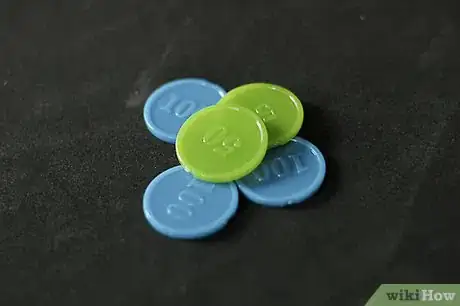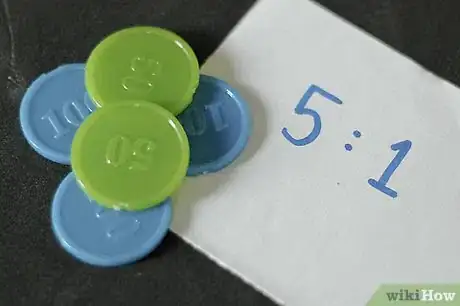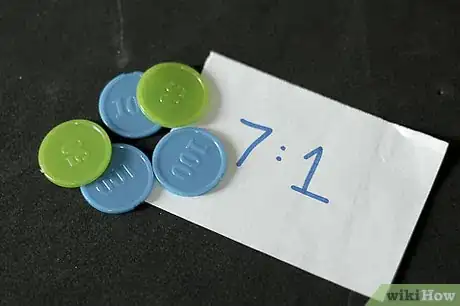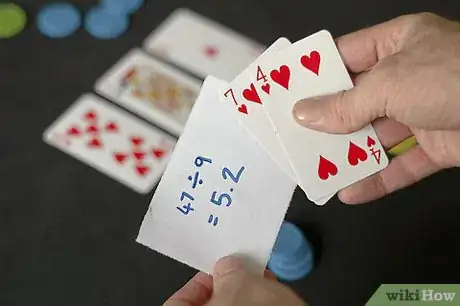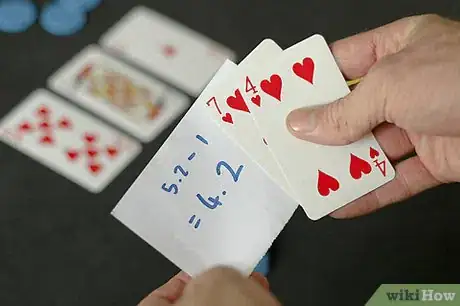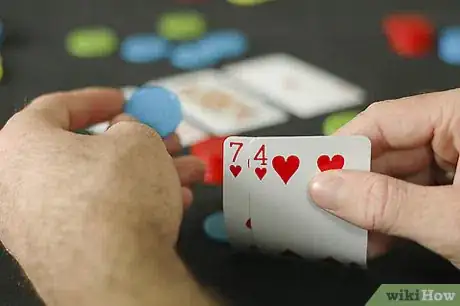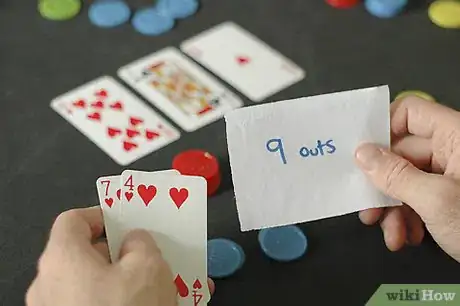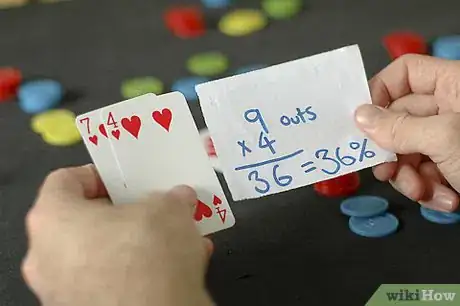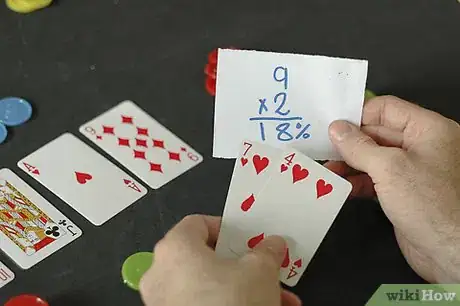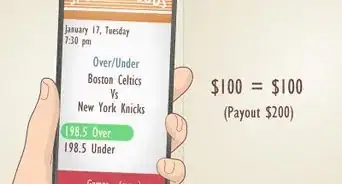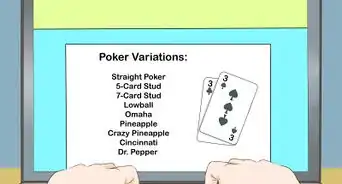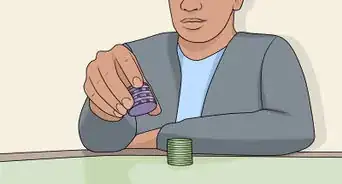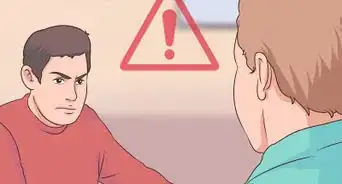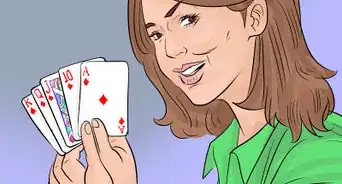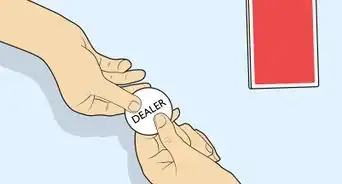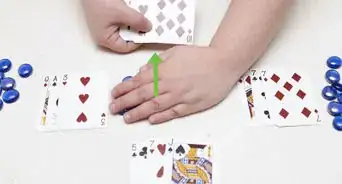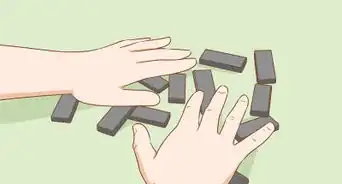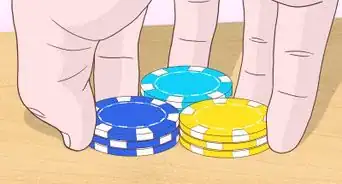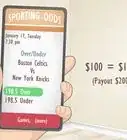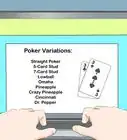wikiHow is a “wiki,” similar to Wikipedia, which means that many of our articles are co-written by multiple authors. To create this article, 33 people, some anonymous, worked to edit and improve it over time.
This article has been viewed 286,424 times.
Learn more...
When playing poker, you are often faced with the decision whether to call or fold to a bet. One way to determine whether to call is to see if the amount of money in the pot, divided by your call ("pot odds"), equal or exceed the odds of you getting the cards you need for a winning hand (also called your 'hand odds', or 'outs').
Quickly calculating whether the pot odds you are getting are favorable is essential to a long term winning strategy. In other words, usually only make or call a bet if it will pay off in the long run, keeping your play variable enough to avoid getting 'read'.
Steps
Pot Odds
-
1Determine the total amount of money in the pot. If you are playing pot limit or no limit poker, you should already know this number.[1]
-
2Divide by the amount you need to call. Pot odds are invariably a function of calling or folding, rather than betting. In the simplest terms, if the bet is $1 to you, and there is already $4 in the pot, your pot odds are 5:1.[2]Advertisement
-
3Pot odds are fixed; there is no actual calculation. However, 'implied odds' should be added in for the most accurate picture. In the scenario above, although your pot odds are 5:1, if there are 2 other people in the hand 'behind' you that haven't acted yet, and they each have $1 in their hand, waiting for you to call so they can call (bad poker etiquette), your implied odds, for just this round of betting, instantly rise to 7:1, as an example. Implied odds are calculated, since they are basically imaginary, and encompass more than just the scenario above, which is vastly simplified; in the scenario above, if the second person waiting to call behind you instead raises, you have to start all over.[3]
Hand Odds
-
1Divide the number of cards unseen by the number of "outs" that you have. "Outs" are the cards remaining in the deck that will allow you to make a winning hand.[4]
-
2Subtract 1.
-
3There must be at least that many bets in the pot (multiples of your bet) for a call.
- Example: You have 2 hearts. Two more hearts fall on the flop. There are now 47 unseen cards. You have 9 outs (9 out of 13 unseen hearts remaining in the deck) to make your flush on the next card.
Divide 47 by 9 = 5.2
Subtract 1 = 4.2
There must be at least 4.2 bets in the pot for you to call a single bet.
- Example: You have 2 hearts. Two more hearts fall on the flop. There are now 47 unseen cards. You have 9 outs (9 out of 13 unseen hearts remaining in the deck) to make your flush on the next card.
Rule of 4 Version
-
1After the flop determine the number of outs you have.
-
2Multiply that number by 4. That is your percentage of catching one of your outs.[5]
-
3After the turn you multiply your outs by 2.[6]
- Example: You have two hearts. Two more hearts fall on the flop, so you have 9 outs.
9 x 4 = 36, giving you 36% chance to hit your flush and your opponent a 64% chance to hold up and win with a pair.
64/36 is a little less than 2 to 1. Therefore, it would make sense to call bets slightly higher than half the pot size.
If another heart doesn't hit on the turn you are now 9 x 2 = 18%
18%/82% is a little worse than 5 to 1, meaning the bet has to be less than 20% of the pot.
- Example: You have two hearts. Two more hearts fall on the flop, so you have 9 outs.
-
4
| Draw | Hand | Flop | Specific Outs | # Outs |
|---|---|---|---|---|
| 4♠ 4♥ | 6♣ 7♦ T♠ | 4♦, 4♣ | 2 | |
| One Overcard | A♠ 4♥ | 6♥ 2♦ J♣ | A♦, A♥, A♣ | 3 |
| Inside Straight | 6♣ 7♦ | 5♠ 9♥ A♦ | 8♣, 8♦, 8♥, 8♠ | 4 |
| Two Pair to Full House | A♦ J♥ | 5♠ A♠ J♦ | A♥, A♣, J♠, J♣ | 4 |
| One Pair to Two Pair or Set | J♣ Q♦ | J♦ 3♣ 4♠ | J♥, J♠, Q♠, Q♥, Q♣ | 5 |
| No Pair to Pair | 3♦ 6♣ | 8♥ J♦ A♣ | 3♣, 3♠, 3♥, 6♥, 6♠, 6♦ | 6 |
| Two Overcards to Over Pair | A♣ K♦ | 3♦ 2♥ 8♥ | A♥, A♠, A♦, K♥, K♣, K♠ | 6 |
| Set to Full House or Quads | 5♥ 5♦ | 5♣ Q♥ 2♠ | 5♠ Q♠, Q♦, Q♣, 2♥, 2♦, 2♣ | 7 |
| Open Straight | 9♥ T♣ | 3♣ 8♦ J♥ | Any 7, Any Q | 8 |
| Flush | A♥ K♥ | 3♥ 5♠ 7♥ | Any heart (2♥ to Q♥) | 9 |
| Inside Straight & Two Overcards | A♥ K♣ | Q♠ J♣ 6♦ | Any Ten, A♠, A♦ A♣, K♠, K♥, K♦ | 10 |
| Flush & Inside Straight | K♣ J♣ | A♣ 2♣ T♥ | Any Q, Any club | 12 |
| Flush and Open Straight | J♥ T♥ | 9♣ Q♥ 3♥ | Any heart, 8♦, 8♠, 8♣, K♦, K♠, K♣ | 15 outs |
Warnings
- The video is only useful for the description of 'Pot odds'; following any of it's other advice, trying to win with a 6 high flush, for example, will have you playing with play chips' in no time.⧼thumbs_response⧽
References
- ↑ https://www.pokerlistings.com/strategy/poker-math/how-to-calculate-pot-odds-and-equity-equity
- ↑ https://upswingpoker.com/pot-odds-step-by-step/
- ↑ https://www.cardschat.com/odds-for-dummies.php
- ↑ https://www.tightpoker.com/texasholdem/odds_holdem.html
- ↑ https://www.cardschat.com/odds-for-dummies.php
- ↑ https://www.cardschat.com/odds-for-dummies.php
